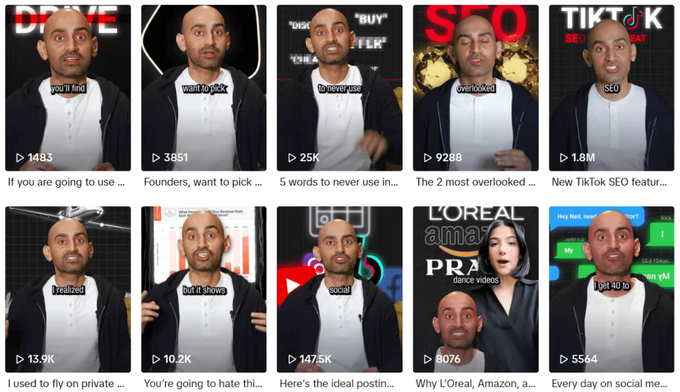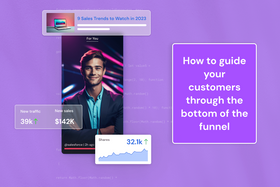Navigating short-form video: Key challenges and how to overcome them
Discover how to navigate the challenges of maintaining relevancy, expertise, and authenticity in your short-form video content strategy.
Updated April 4, 2024

Key takeaways
- 91% of marketers use video as a marketing tool.
- Creating short-form videos comes with challenges.
- Using expertise in videos is the best way to deliver valuable content.
- Authentic content should always be the aim behind your content strategy.
89% of consumers are seeking more video content from brands in 2026 over other forms of content. The necessity of creating videos for social media to boost your marketing strategy is clear.
American adults spend more than 46 minutes a day on TikTok, so getting your brand seen by the right people on this platform is becoming more likely.
According to HubSpot's video marketing report, short-form videos have the highest ROI out of any other content type. But before you start producing short-form videos, you need to be aware of the challenges that come with creating them.
Common challenges in creating short-form video
Businesses starting their short-form video strategy need to be aware that for these videos to be effective, they demand the following:
- High relevancy: Businesses need to produce videos that are relevant to them, their audience, and their conversion funnel.
- Expert insights: Experts add depth to the information businesses share, but it's difficult to find the right expert who aligns with your brand to create content.
- Unique perspectives: Currently, there is a hyperinflation of content, and many people are regurgitating the same information, hoping to get noticed. To stand out, businesses need to share unique ideas that only they can deliver.
» Find out how to create authentic expert content.
The scarcity of experts with the ability to present engaging content coupled with time constraints and expertise requirements present a challenge in maintaining quality and relevance across short-form videos.
Businesses that sell products are usually better at creating informational content that educates and demonstrates expertise instead of purely entertaining content. Some businesses like Nike, ScrubDaddy, and Hydro Flask have managed to bridge the entertainment and informational content divide, but these are fairly uncommon.
How to overcome the challenges of creating short-form videos
To address these challenges, businesses should:
- Leverage expertise
- Implement strategic content creation processes
- Focus on engagement and relevancy
Leverage expertise
By having experts present the content, businesses can address the challenge of maintaining high expertise levels in their videos, ensuring that the information shared is accurate, valuable, and authoritative.
Take this example from BetterHelp.
The video highlights the presenter as a licensed therapist and then introduces useful concepts in an easy-to-remember format.
But how do you find experts? Here are some solutions:
- Influencers: Collaborate with influencers who can create content on behalf of the business. While influencers can be effective in reaching a wider audience, this approach can be costly, similar to traditional paid advertising, and may not fully align with your brand.
- In-house presenters: Find a good presenter within the company who has subject matter expertise and strong presentation skills. This can be difficult, but it offers the greatest opportunity for brand alignment.
- Expert marketplaces: Businesses can use marketplace platforms to connect with presenters who can showcase their products or services. To make sure you're getting the best person for the job, an expert marketplace can offer the right fit for your brand while helping you maintain authenticity.
Use a well-thought-out content strategy
Developing a streamlined process for creating high-quality short-form videos at scale is essential. This involves strategizing the type of content to create, identifying relevant topics, and planning the distribution of videos across various platforms.
Neil Patel is a great example of how you can scale your short-form video by creating a strong strategy. He posts a new video every day in the same format and shares well-researched insights that are valuable for the viewer.
Implementing a structured approach to content creation, including scripting, filming, editing, and distribution, can help businesses overcome the challenges of maintaining consistency, quality, and relevance in their video content.
» Find out how to build a high-converting content strategy.
Focus on engagement and relevance
Emphasizing the importance of creating content that is not only informative but also engaging is crucial. Businesses should strive to produce videos that capture the audience's attention, evoke emotions, and drive viewer interaction, such as in the example below.
By aligning video content with the needs and interests of the target audience, businesses can enhance engagement, build brand credibility, and drive meaningful interactions that lead to conversions.
How to measure short-form video performance
Measuring your performance is essential to improve your efforts as you scale. To measure your performance, focus on these three elements:
- Estimated media value (EMV): Based on views and engagement metrics like comments, likes, shares, and saves. Each engagement action carries a different weight, and when factored together, they contribute to the overall estimated media value of a video.
- Relevancy and conversion potential: Relevancy plays a crucial role in measuring video performance as it directly impacts conversion potential. The more relevant the content is to your business and target audience, the higher the potential for conversion. Relevancy multiplies the impact of engagement metrics, making them more valuable for the business.
- Content type and conversion probability: Different types of content have varying conversion probabilities. Product demos or walkthroughs tend to convert well as they showcase the product directly. Bottom-of-the-funnel content that focuses on why to use a product or service also holds high relevancy and conversion potential. On the other hand, broader informational topics may have lower conversion potential but can help generate brand awareness.
» Learn how to create content for the conversion funnel.
Start creating short-form videos today
Ultimately, this is a creative process, and you will encounter challenges unique to your process and business. Armed with the knowledge of the common challenges faced by brands and the solutions to overcome them, you can start creating content that will engage your audience and lead to conversions.






